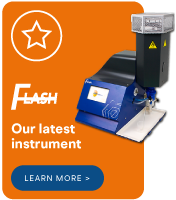
The best equipment in the world is useless without calibration. Much has been done by BWB to automate the process with Flame Photometers for consistency, reliability, and repeatability. While others lag behind, we’re making flame photometry better, faster, and more efficient.
Our objective is to eliminate (as far as possible) human error by using an internal computerized process that tells the operator when to introduce the various solutions for calibration.
Many existing flame photometers still require the user to stay in the lower concentration ranges, for example, of 50 ppm or less, and to manually calibrate using a “Blank” testing solution, and a “Standard” testing solution (more on those in a moment), and then read the results out directly from the meter or display.
Otherwise, operators were required to manually plot a calibration curve for the Blank and several Standards, which were then interpolated from the graphing results. So much work—and so many opportunities to introduce errors into the calculations!
By automating the process as much as possible, telling the operator when to introduce the various liquids, the calibration curve is graphed automatically, using a Blank and a Standard preparation (or optionally more to enhance accuracy).
Blanks & Standards
So, what are these Blanks & Standards? They are the very foundation for ensuring accuracy in Flame Photometer results!
Standard Solutions
Standards are solutions prepared with a single element being tested. Standard solutions for Sodium might be 5ppm, 10, 25, 50, 70, 85, 100, 120, or any number you desire that covers the expected range of your sample or samples.
Values, sometimes with ranges significantly higher or lower, are used for the other elements, including potassium, lithium, calcium, or barium. In the latter case of barium, for example, you should not set a high value lower than 300 ppm because of sensitivity issues. Lower values for barium standard solutions could decrease to as little as 50 for the sake of building the calibration curve, but higher is clearly better for accuracy.
For example, with the barium thought… If you knew values would be in the low range, your test substance could be concentrated through evaporation. Halving its volume would double the concentration, obviously. You can therefore easily calculate that something reading 268ppm would really represent 134ppm, but be assured of a much higher accuracy rate in your final results.
Blank Solutions
Blank Solutions, on the other hand, contain all of the constituents of the standard solutions, with the exception of the element that is being tested. Additionally, if a test sample also contains a quantity of hydrochloric acid, then the Blank Solution should contain the same quantity of HCL as the sample. This avoids crosstalk, or ionic interference, and keeps the results accurate.
Making Standards and Blanks
Both of these solutions should be prepared or purchased as Stock Solutions in very high concentrations such as 10,000ppm. They can be diluted to the necessary PPM when used, but low PPM solutions should not be stored since time causes ionic degradation rendering them inaccurate.
World-wide “Never Flush Drugs” campaigns have had limited success. It’s hard to impress the importance of returning unneeded drugs to the local chemist/pharmacist for proper disposal when people think “What’s the harm in flushing just three little Valium pills?” Why is this important?
All Standards and Blanks are prepared with diluents, typically deionized, distilled, or double-distilled (DD) water. Conventional water supplies are rife with sodium, calcium, and potassium. However, urban water supplies are often contaminated with barium and lithium from improper disposal of unused medications or industrial substances into the sanitary sewers. It is vital to use the purest water available for preparing these solutions.
Similarly, diluents should be stored in sealed (non-glass) containers so as not to be contaminated by airborne particles, or experience over-concentration due to the evaporative processes.
Serial Dilutions
Given a Stock Solution of 10,000ppm, a 1,000ppm solution is prepared by placing 10ml of stock in a 100ml volumetric flask, and filling with deionised water (distilled or DD water) to the 100ml mark. Decant this into a container marked 1,000ppm.
Take 10ml of the new 1,000ppm solution, place it in a 100ml volumetric flask, and fill it with deionised water to the 100ml line. Decant that into a new container marked 100ppm. Repeat the process again to make 10ppm and finally one more time to make 1ppm solution.
It is a simple calculation to create a 50ppm solution, using 5ml of the 1,000ppm solution in the 100ml volumetric flask, or even 50 ml of the 100ppm solution, depending on need. You are only limited by your ability to perform simple maths, and can get any needed PPM value.
Scales
It should be mentioned that industrial labs and medical labs use different measurements for their professions. Most industrial processes use the PPM scale but medical facilities use the mol/L or mmol/L (moles or millimoles per litre) scale. You can convert between these scales upon need.
While it is possible to calculate the different values and switch between them using a constant called Avogadro’s Number which tells us one mol of any substance contains 6.02 x 1023 particles, it is time consuming. As long as you know the atomic mass of the atom you are examining (e.g. sodium with a mass of 22.99 grams per mol) it is quicker to use an online converter or download one onto your own computer, just for the sheer speed and convenience.
The Takeaway
Using Standard Solutions provides reliable, consistent results. BWB provides your new system with everything you need, right out of the box! The only thing you need to provide is the fuel—propane, butane, or a commercial mixture combination called Liquid Petroleum Gas or LPG.
Set up is quick and easy, and all the instructions are included. If you are looking for the cutting edge in flame photometry, and a team that is always ready to support you, look no further than BWB.
Give us a call today! We would love to help you become the experts that customers rely on every day!




